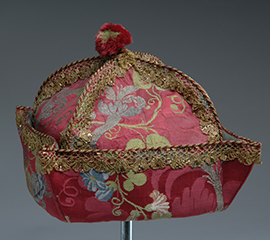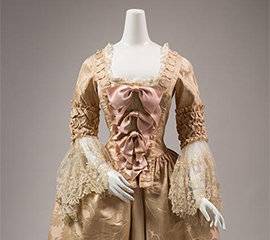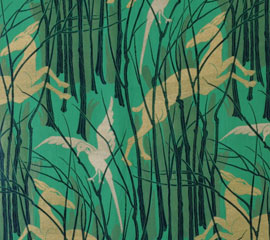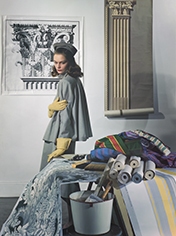New Acquisitions
For more information about how you can support the activities of The Museum at FIT, please visit Support MFIT.

Hip hop aficionados draw fashion inspiration from a wide array of sports from basketball
and football to hockey and polo. The interest in polo is not surprising considering
that hip hop favorite Ralph Lauren designs a large collection centered on the sport.
Although the game of polo, involving
horses and mallets, is obscure to most people, polo shirts are ubiquitous in men's
fashion.
This shirt was on view in the 2023 exhibition Fresh, Fly, and Fabulous: Fifty Years of Hip Hop Style.

"Fashion is something of the marvelous, something to take you away from everyday life."
—Christian Dior
Although feathers have been associated with luxury fashion for centuries, ethical,
environmental, and legal concerns have diminished their use in recent years.
This bolero jacket was on view in the 2025 exhibition Fashioning Wonder: A Cabinet of Curiosities.

Bell sleeves, sometimes called trumpet sleeves, are characterized by a flare below the elbow. They may have a straight or an asymmetrical hem—the latter of which gives Yves Saint Laurent’s version its dramatic look.
This dress was on view in the 2024 exhibition Statement Sleeves.

This dress could be interpreted as a metaphor for body and self in a state of transformation. Reviewers described it as "fairy-dandelion explosion" and an image of an "extra-dimensional being soaring upward." The Japanese avant-garde designer Kei Ninomiya said that with this collection for Noir, he wanted to express "mystical forces.".
This dress is currently on view in the 2025 exhibition Dress, Dreams, and Desire: Fashion and Psychoanalysis
Below are the types of objects in the collections of The Museum at FIT.

The accessories collection consists of approximately 15,000 objects that date from the mid-17th century to the present day. The collection has a particularly strong emphasis on designer accessories from the second half of the 20th century.
The accessories collection is supported by the Solomon-Sloan Endowment Fund, which was established in 2005 to facilitate the acquisition, conservation, documentation and exhibition of accessories.
- The footwear collection contains more than 4,000 pairs of shoes, boots and sandals. It includes examples by designers such as Manolo Blahnik, Roger Vivier, Herbert Levine, and Salvatore Ferragamo.
- The millinery collection contains more than 3,000 hats by famous milliners such as Caroline Reboux, Lilly Daché, Halston and Philip Treacy. There are also many examples from designers such as Christian Dior, Balenciaga and Jacques Fath.
- <The handbag collection includes fine examples by luxury houses such as Hermés and Gucci as well as examples by Roberta di Camerino, Judith Leiber and Bonnie Cashin for Coach.
- Other accessories include fans, gloves, belts, hosiery and costume jewelry.

The Costume Collection consists of more than 50,000 objects dating from the mid-18th century to the present. The strength of the collection lies in its 20th-century holdings and, particularly, in couture and ready-to-wear women's clothing. The collections are currently being computerized to facilitate research.
- The costume collection includes fashion by designers such as Azzedine Alaïa, Balenciaga, Chanel, Comme des Garçons, Dior, Galanos, Halston, Charles James, Norell, Paul Poiret, Yves Saint Laurent, and Vivienne Westwood.
- The Halston Archives and Study Room hold designs, patterns, and related records documenting this important designer's life work.
- The menswear collection features some 2,000 garments ranging from formal to activewear, including suits, coats, vests, and uniforms.
- Also included are swimwear, lingerie, outerwear, and knitwear.

The Textile Collection consists of more than 30,000 textiles dating from the fifth century to the present, and includes the work of artists and designers such as Junichi Arai, Salvador Dali, Raoul Dufy, and William Morris.
- The textile collection includes apparel and home furnishing fabrics, embroideries, and shawls.
- The collection also includes a number of ribbon sample books.
- The J.B. Martin Velvet Room archives handwoven and production velvets spanning a 125-year period.

The Photography Archive features the work of fashion photographers Louise-Dahl Wolfe (1895-1989), who produced 86 cover images and thousands of interior shots for Harper’s Bazaar magazine, and John Rawlings (1912-1970), who had more than 200 Vogue and Glamour magazine covers.
Image: Louise Dahl-Wolfe photograph of model Sandra Payson. Featured in Harper’s Bazaar, March 1947, page 205, gift of Louise Dahl-Wolfe, 74.84.54
For those looking for the Herman Landshoff collection, the archive has been transferred
to:
Munchner Stadtmuseum
Sammlungsleiter Fotomuseum
St.-Jakobs-Pl. 1
80331 Munchen
The contact for the collection is:
Dr. Ulrich Pohlmann
Tel.: 089/233-22948
Fax.: 089/233-27969
email.: [email protected]